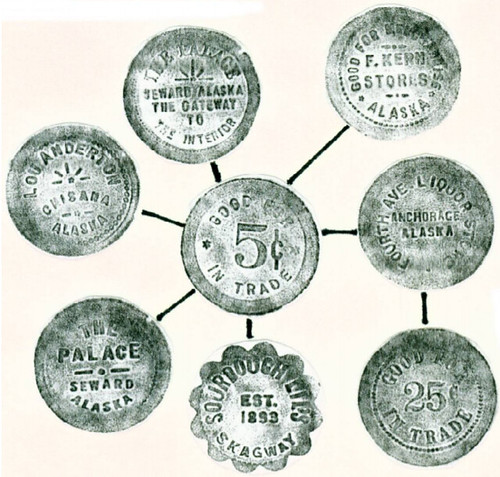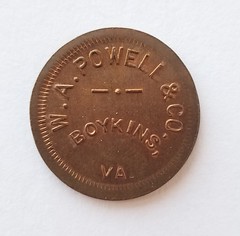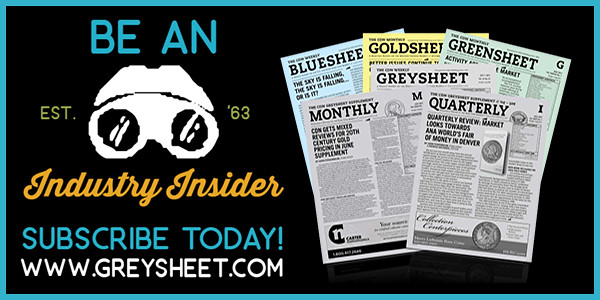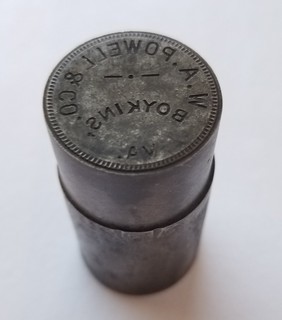
PREV ARTICLE
NEXT ARTICLE
FULL ISSUE
HOW TO HANDLE SELLING TOKEN AND MEDAL DIESTom Casper writes: I read with interest the article in the last issue of The E-Sylum on the Anillo restrikes. I am aware of the problems they can cause for collectors, dealers and auction companies. Down the line these pieces are ultimately offered for sale as original strikes rather than restrikes or die-trial tokens, which is deceiving to the buyer. I have a large collection of old token and medal dies. To prevent a repeat of Anillo problem, I was wondering if your readers have any suggestions for me before I dispose of this collection. My own take is that I hate to see people defacing dies to prevent nefarious uses. I would rather be careful to whom they are sold and consider publishing a catalog of them so
that if restrikes do appear, they could be recognized as such.
By coincidence, in a companion article to the one on the tokens of the Chisana gold rush in the January 2018 issue of Alaskan Token Collector & Polar Numismatist (see the article preceeding this one), editor Dick Hanscom discusses fantasies of the Chisana tokens struck from the original dies. With permission, here's an excerpt. -Editor Editor’s Note: We acquired these dies, along with others from Dale Noll, a California collector about 1984/1985. We sold them to a local collector, and reacquired them in the last few years. At least the 25¢ obverse die was use to make fantasy restrikes before we acquired them the first time. MORE ON THE CHISANA RESTRIKES In the June, 1991 issue of Alaskan Token Collector & Polar Numismatist, I did an article on “Mint Sports.” These are “tokens” that were struck using the wrong die pairings, made to deceive. However, in this case, either that was not the purpose, or they were so badly done that anyone knowledgeable about Alaska tokens would not be deceived. I purchased several dies in 1984/1985. From the article, it appears that I still possessed the Chisana 25¢ obverse die in 1991.  There are several token dies paired with a 5¢ reverse. These rubbings show something interesting. In this grouping, all of the planchets appear to be oversized, the tokens showing a very broad rim. Jump ahead to 2017. I have re-acquired the Chisana dies, and decided to “play” with them. When I tried to make a blank for the Chisana 25¢ and 50¢ dies, I did not have a disc cutter the correct size. And I have 3 sets of disc cutters, all with cutters larger and smaller than the required size. What does this tell me? It tells me that the last person to use these dies, and make the “mint sports” also did not have a disc cutter the correct size. As a matter of fact, it was the same size that I used to make the blanks for the 25¢ die! It is interesting to note that the maker of these “mint sports” did not have the right size disc cutter, but did have access to octagonal and scalloped planchets. In this case, there are clear physical indicators that the tokens are not original.
Dick adds: Ron Benice in his book Alaska and Yukon Tokens makes a note of dies still known to be in existence with a little [D] in the listing with the tokens. There are a lot of them. I also reached out to Token and Medal Society officers Eric Schena and Dave Schenkman for their thoughts on the topic. -Editor Eric Schena writes: I have to say that the idea of defacing a die is anathema to me too, though I completely understand the rationale for doing so. I collect token dies mostly from the Mid-Atlantic states, partially with the intent to keep them from being used to make restrikes or fantasies. I have made a point of doing exactly what Wayne suggests: maintaining a catalog of dies so that records of what dies are out in the wild are known. I feel that the dies themselves are valuable artifacts in their own right, so I am averse to defacing them. The S. H. Quint's Sons Company of Philadelphia was a major producer of trade tokens and badges for many years. In the 1960s, Quint sold off their stock of trade token dies since they were moving away from that business - some 10,000 or 20,000 dies all told. They were sold in groups and there are even some ads in the TAMS Journal for them.
I have a couple of these fantasies (though I paid nothing for mine - I have seen these sell for crazy amounts, though) and will use them as educational tools. Fortunately, I managed to get those very dies recently and they will not be used for that purpose, at least not under my custodianship. I have about 60 such dies in my collection and hope to publish them at some point. I believe that publishing this information helps at least raise awareness enough so that as few people as possible are taken in by these things without having to resort to destroying the dies. So, my advice would be to preserve them, but publish them. Spread the word and that will go a long way. Maybe write a catalog and perhaps contact TAMS for publishing in the TAMS Journal (Tom can contact me if he so wishes). At a bare minimum, find someone you can trust won't use them to make restrikes or fantasies.   W. A. Powell Fantasy Token (die shown above) Images courtesy Eric Schena Dave Schenkman writes: Eric summed it up well. Another suggestion would be to donate them to the American Numismatic Association. I became acquainted with Carmen Valentino in 1968, around the time he joined the Token and Medal Society. Carmen had made an arrangement with S. H. Quint’s Sons Co. of Philadelphia to sell their old token dies; thousands of them. I purchased most of the Virginia token dies, and as I recall he charged me $7.50 each. These were just obverse dies, not matched pairs, although I did get ten dies from Planters Nut and Chocolate Company of Suffolk, VA; he sold me the matched obverse/reverse pairs because on these dies the company name appeared on each side. Thanks, everyone! Certainly, a donation to a numismatic museum would impound the dies beyond the reach of those who would attempt to deceive by making clandestine restrikes. But
restrikes and fantasies have a long history and tradition in numismatics, and when made and marketed openly these items can educate and inform collectors and scholars alike, and become new objects
worthy of study themselves. What do readers think? -Editor
To read the earlier E-Sylum article, see:  Wayne Homren, Editor The Numismatic Bibliomania Society is a non-profit organization promoting numismatic literature. See our web site at coinbooks.org. To submit items for publication in The E-Sylum, write to the Editor at this address: whomren@gmail.com To subscribe go to: https://my.binhost.com/lists/listinfo/esylum All Rights Reserved. NBS Home Page Contact the NBS webmaster 
|
